Data analytics is one of the crucial trends in today’s time. The data aspect is growing and the business challenges and problems are getting more complex. Now organizations have turned to artificial intelligence in an attempt to push those insights further and make better decisions. The enterprise AI tools for data analysis have evolved into game changers as they provide advanced capabilities beyond what traditional analytics methods afford.
In this blog, we’ll delve into the concept of AI-powered data analytics and highlight the top 10 AI-powered data analytics tools for 2024. We’ll also explore the key features that set these tools apart and provide guidance on selecting the best tool for your business needs.
What is AI-Powered Data Analytics?
AI-powered analytics is type of analytics that uses artificial intelligence and machine learning algorithms. This is meant to analyze large volumes of data. It brings patterns, makes predictions, and generates actionable insights. AI-powered analytics is different from other traditional forms of data analytics.
Data analytics primarily relies on human intervention and rules set up beforehand. AI-powered analytics can automatically discover subtle correlations inside the data, adapt according to changing patterns, and provide more timely insights in a far more accurate way.
Techniques on which Ai Powered Data Analytics tools rely on?
These AI powered data analytics tools rely on a set of techniques that include the following:
Machine Learning: Such algorithms can learn from the data themselves and hence improve their performance over time, not needing explicit programming.
Natural Language Processing: The ability to understand, interpret, and generate human language for analyzing unstructured text data.
Computer Vision: AI systems that can analyze and interpret visual information coming from images and video.
Deep Learning: Extremely sophisticated neural networks that can process any quantity of data to discern the most advanced patterns or relationships.
Predictive Analytics: Using history data and AI algorithms in forecasting future trends or outcomes.
6 Key Features of an AI-Powered Data Analytics Tools Essential to Be There
Evaluating AI-based data analytics tools is certainly not an easy task, but careful evaluation will tell if it’s the best solution or mediocre. So here are six must-have key features that define the best solutions from all others.
1. Advanced Data Integration and Preprocessing:
It should be able to integrate data coming from different sources; it may be either structured or unstructured and has far more advanced capability in pre-processing the data with its tools like data cleansing, normalization, and feature engineering to mention a few.
2. Automated Machine Learning (AutoML):
AutoML capabilities enable users to design and deploy machine learning models with little data science knowledge. It democratizes AI because it allows business analysts and domain experts to leverage advanced analytics while relying less on data scientists .
3. Explainability and Interpretability:
As the sophistication of AI models advances, so does the need for understanding and interpreting the decisions. Explainable AI tools provide a view into how the AI came to its decision, which then injects much more trustability and enables the user to validate the insights that came out of it.
4. Real-time Analytics and Decision Support:
Any analysis conducted in real-time within the context of fast business environments has absolute value. Tools that can process data in real time and also grant the benefits of analytics along with possible integration with operational systems for real-time decision support are most suitable.
5. Natural Language Querying and Generation:
Analytics that AI is producing will reach much broader audiences beyond people who are technically competent through the use of natural language interfaces. This is how democratizing company-wide data analysis occurs, whereby the users are allowed to ask plain language questions and receive answers in the form of natural language narratives.
6. Scalability and Cloud Integration:
With escalating volumes of data, scalability is going to be very crucial, as it will provide the capability to support large-scale analytics processing and analysis preferably of cloud-native architectures.
List of Top 10 AI-powered Data Analytics Tools
Here are the top 10 AI-powered data analytics tools that are expected to lead the market in 2024:
1. Tableau
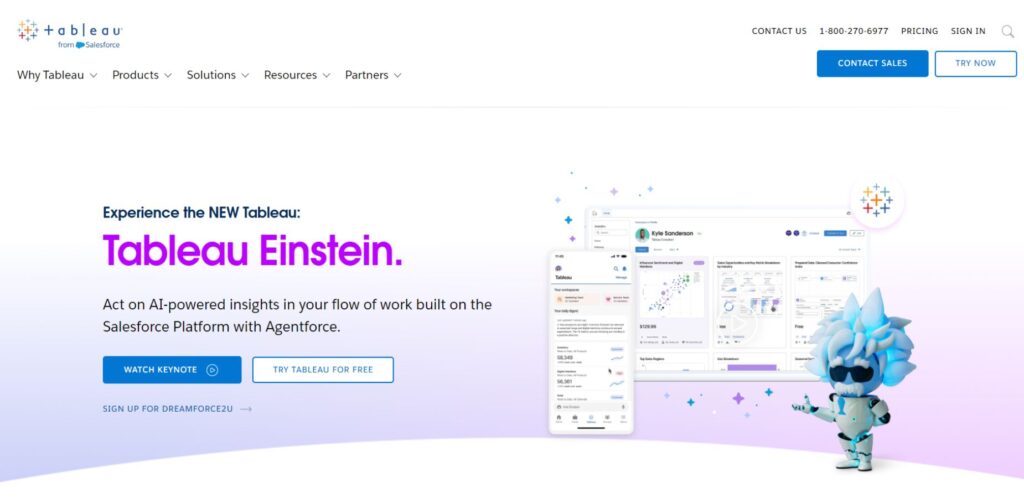
Tableau is a one of the high-performance Ai-powered data analytics tools that has integrated AI capabilities into its analytics products. The intuitive interface, with powerful features, allows for the rapid development of interactive dashboards and reports. The AI-powered analytics in the platform, also referred to as Tableau CRM-or formerly known as Einstein Analytics-deliver predictive insights, automated explanations, and natural language processing. The strength of Tableau is in the fact that it can deal with massive data sets and support multiple data sources hence making it a multi-purpose choice for businesses of all sizes.
Key Features:
- Drag-and-drop interface with visualization
- Artificial Intelligence used in data prep and analysis
- Natural language querying
- Insights and Explanation
- Predictive analytics and forecasting
- Real-time collaboration
Pros:
- Easy interface and easy to use but not intimidating for a beginner at the same time is very convenient for advanced users.
- Extremely big library of visualizations and can be totally customized
- Deep community and abundant learning resources
- Continuously updated and improved
Pricing:
- Tableau Creator: $70 /user /month
- Tableau Explorer: $42/user /month
- Tableau Viewer: $15 /user /month
- Enterprise custom pricing
Website:
https://www.tableau.com
2. Power BI
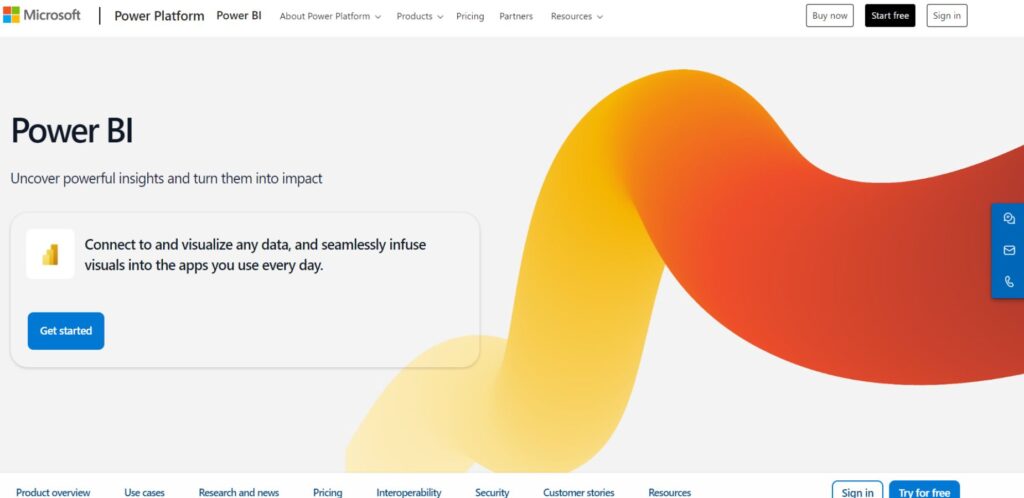
This one of the popular AI-Powered Data Analytics Tools allows natural language Q&A, automated machine learning, and cognitive services in most cases just because of its integration with AI capabilities. Moreover, in addition to working on top of other company products of Microsoft, the platform allows working with real-time data.
The AI insights generated by Power BI help users perceive what is hidden in their data, extracting unconscious patterns from trends; thus, it’s easier to make decisions based on the data. This is one of the best Ai-driven data analytics tools.
Key Features
- Q&A on natural language by AI
- Quick Insights on automated data analysis
- Integration with Azure Machine Learning
- Real time analytics
- Personalization for customized dashboards and reports
- Mobile application to have analytics on the go
Key Features:
- Extremely well integrated with the Microsoft ecosystem
- Economically friendly to organizations already working on Microsoft products
- Silk-smooth rollouts of features and improvements
- Robust security and governance attributes
Pricing:
- Power BI Pro: $9.99/user/month
- Power BI Premium: Starting at $4,995 /month with access to dedicated cloud compute and storage resources
- Free version available with reduced functionality
Website:
https://www.microsoft.com/en-us/power-platform/products/power-bi
3. KNIME
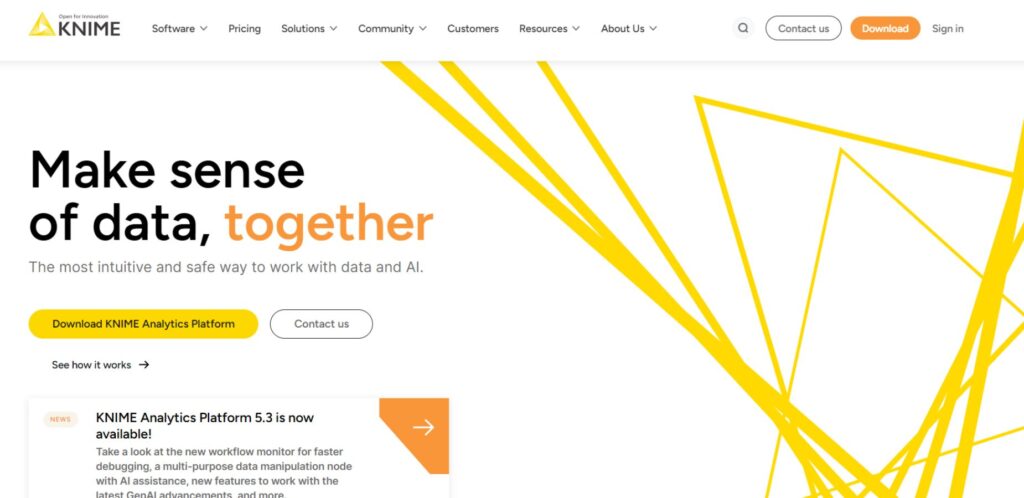
KNIME is free, and one of the best open-source AI-Powered Data Analytics Tools joined with data mining, machine learning, and artificial intelligence. KNIME helps its users develop a visual workflow of data science without writing an extended code. Applications provided by KNIME AI are auto ml, deep learning, and natural language processing.
One of the primary factors that made this platform highly versatile is the great repository of nodes and integration it offers, thereby being extensible. It is one of the free Ai-powered Data Analytics tool.
Key Features:
- Data science process visual workflow designer
- Machine learning
- Deep learning and neural network
- Text processing and natural language understanding
- Strong library of pre-built nodes and extensions
- Language and programming language integrations with languages like Python and R
Pros:
- A very versatile, open source programming platform
- Extensible through multiple plugins and custom nodes
- Versatile for code-based and visual programming
- Ideal for both beginners and experienced professionals
Pricing:
- KNIME Analytics Platform: Free and Open-source
- KNIME Server: Pay according to enterprise-specific offers
Website :
https://www.knime.com
4. Qlik
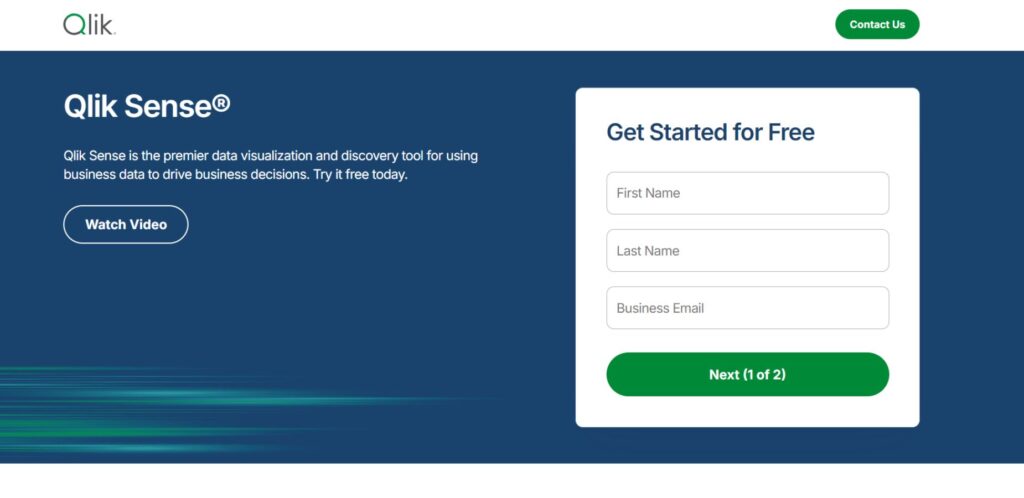
Qlik is an independent software and one of the best AI-powered data analytics tools and business intelligence that uses AI to provide ultimate insights and data-driven decision-making. The application is supported by an associative engine, which gives a user the capability to explore the relevant data relationships very often missed by query-based tools.
Qlik’s Cognitive Engine is A and M done to provide auto-driven insights, chart suggestions, and more interaction through natural language. The ability to process big data in memory ensures the app is apt for companies that have large datasets, which are complex.
Key Features:
- Associative engine with ability to discover relationships in data.
- AI-based Cognitive Engine to enable automatic insights.
- Natural language processing for conversational analytics.
- Augmented intelligence capabilities.
- Data preparation and integration via self-service.
- Multi-cloud architecture support.
Pros:
- Associative models are powerful to uncover hidden information.
- Built-in governance features with robust security.
- Highly scalable enterprise-level deployment.
- Mobile analytics at maximum strength.
Pricing:
- Qlik Sense Business: $30/user/month.
- Qlik Sense Enterprise: customer deployment option-specific pricing
- Also free to use for a trial period.
Website:
https://www.qlik.com
5. IBM Watson Analytics
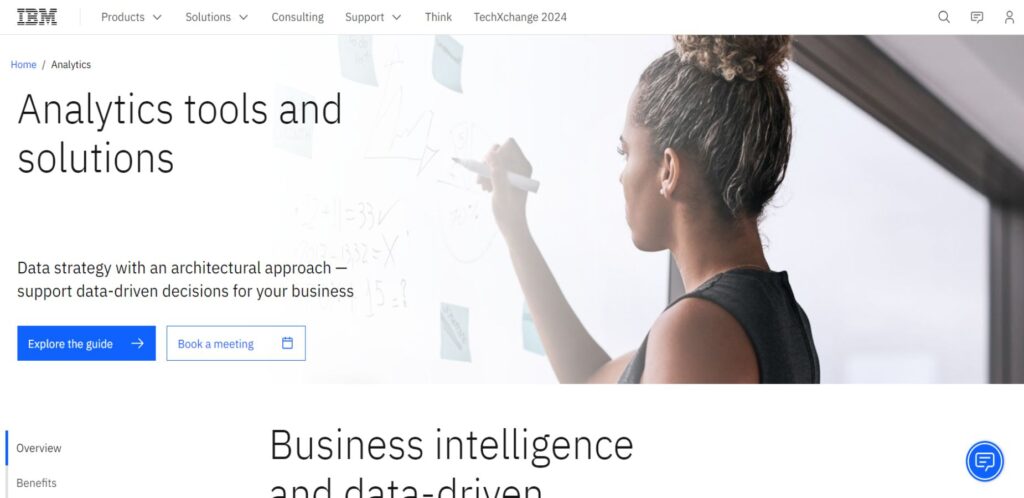
IBM Watson Analytics is an artificially intelligent system which offers analytics in the cloud. This is available through natural language processing and machine learning. Automated data preparation, predictive modeling, and natural language querying make this available to users irrespective of the technical level of the user.
Here, Watson Analytics truly shines through in processing and analyzing unstructured data, such as text and social media content. This cognitive ability of the platform is very useful in interpreting intricate questions while bringing insight with corresponding visualizations.
Key Features:
- Natural Language Querying and Generation
- Automated Data Preparation and Cleansing
- Predictive Analytics and Statistical Modeling
- Text Analytics and Sentiment Analysis
- Smart Data Discovery and Visualization Recommendations
- Interoperability with IBM Cloud and other data sources
Pros:
- Its natural language processing capabilities are extremely powerful.
- Both structured as well as unstructured analysis can be performed
- Suitable user interface for nontechnical users.
- It completely integrates with the other IBM products and services.
Pricing:
- According to one’s specific needs and the actual intended deployments
- Free trial is available
Website:
https://www.ibm.com/watson-analytics
6. RapidMiner
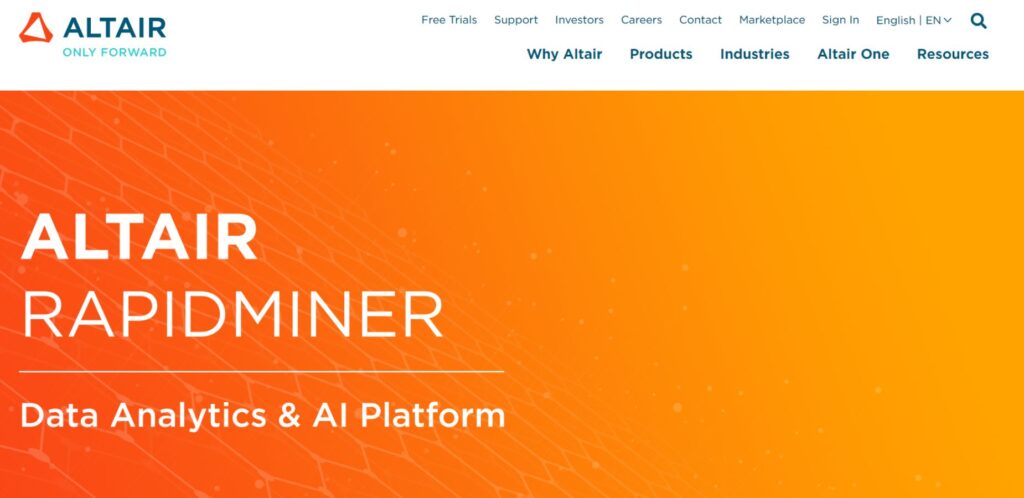
RapidMiner is one of the end-to-end Ai-driven data analytics tools offering AI and machine learning capabilities. Such a platform can be visualized with a workflow designer. This allows users to build complex data pipelines and models without needing extensive coding. The major features that comprise the AI system that the software provides include automated deep learning as well as text analytics besides providing automation for machine learning.
It is famous for extensibility with support that covers the whole lifecycle of a data science product, from preparation of data to model deployment and monitoring. It is magnificent for team-based projects in the enterprise environment due to its collaborative features.
Key Features:
- Visual workflow designer for data science processes
- Automated machine learning (Auto ML)
- Support for deep learning and neural networks
- Text and sentiment analysis
- Model ops for deployment and monitoring
- Enormous number of operators and extensions available
Pros:
- Totally an end-to-end data science platform
- Well suited for collaboration and project management
- Rich documentation and learning artifacts
Pricing:
- Free edition: Core features available
- Profession: $5,000
- Enterprise: $ 10,000
Website:
https://rapidminer.com
7. Microsoft Azure Machine Learning
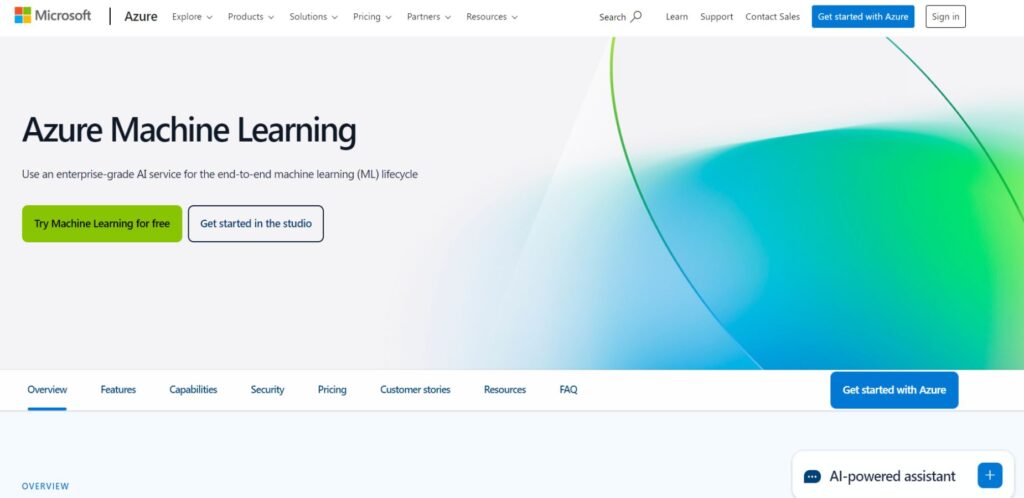
It is considered as one of the versatile Ai-powered analytics tools. It is a cloud-based ML ssolution which gives all the tools and services to design, train and deploy ML models. One of the strengths is it provides a variety of capabilities in AI, like auto-ML, computer vision, and natural language processing.
It becomes a very powerful choice for any organizations already invested in the Microsoft ecosystem because it integrates really well with the other services available under the Azure suite. A big strength of Azure ML is it can scale up to a degree where even big machine learning projects can run in actual production environments.
Key Features:
- AutoML
- Drag and drop interface for model building
- Support for code-based development in Jupyter Notebooks .
- MLOps capabilities for model deployment and management
- Integrate with Azure Cognitive Services .
- Support for open-source frameworks TensorFlow and PyTorch.
Pros:
- Scalable infrastructure especially for ML projects with huge scale
- Scales up really well with other services offered by Azure .
- MLOps have impressive capabilities
- Both low-code and code-first approaches are supported
Pricing:
- Pay-as-you-go pricing model, with consideration for compute and storage usage
- Free resources from a limited free tier.
- Enterprise agreements are available for large deployments.
Website:
https://azure.microsoft.com/en-us/services/machine-learning/
8. Databricks
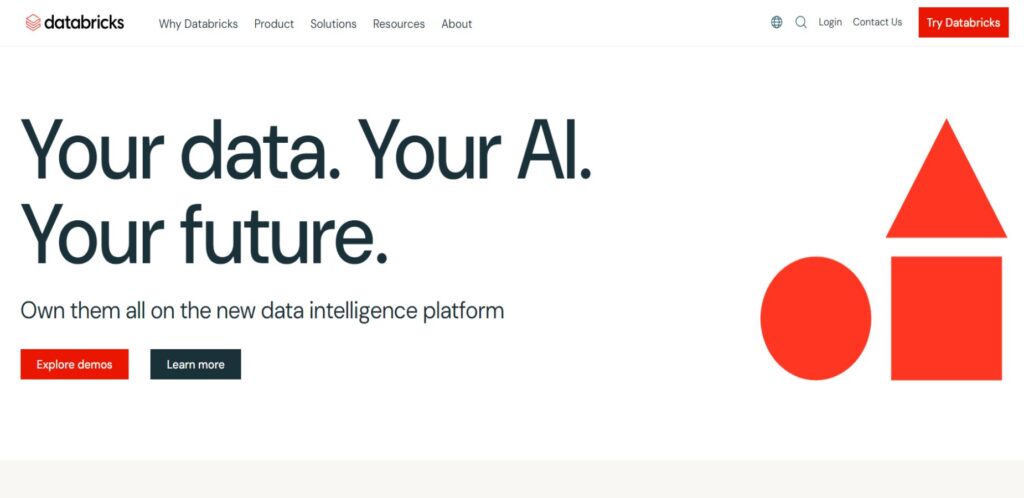
Databricks is one of a Ai-powered data analytics tools. It offers capabilities such as data engineering, machine learning, and business intelligence. Being an Apache Spark-based product, it provides the user with very high-speed distributed computing capabilities to process vast amounts of datasets. The AI capabilities of Databricks include AutoML, deep learning libraries, and also integration with popular ML frameworks.
It boasts outstanding capabilities in collaborative data science; it enables teams to work on notebooks, share insights, and even deploy models at scale. Its architecture for lakehouse unifies the way you treat structured and unstructured data.
Key Features:
- Data science and analytics collaborative notebooks
- AutoML to build and tune models automatically
- MLflow to manage the ML life cycle effectively
- Delta Lake for reliable data lakes
- Integration with popular ML libraries and frameworks, scalable compute for big data processing
Pros:
- Big data analytics and machine learning with powerful platform
- Makes deep collaboration on data science teams possible
- Integrates well with engineering and ML workflows, extensible; very suitable for enterprise deployments
Pricing:
- Custom pricing according to deployment options and usage of resources; free edition named Community, which lacks some of the functionalities
Website:
https://databricks.com
9. Sisense
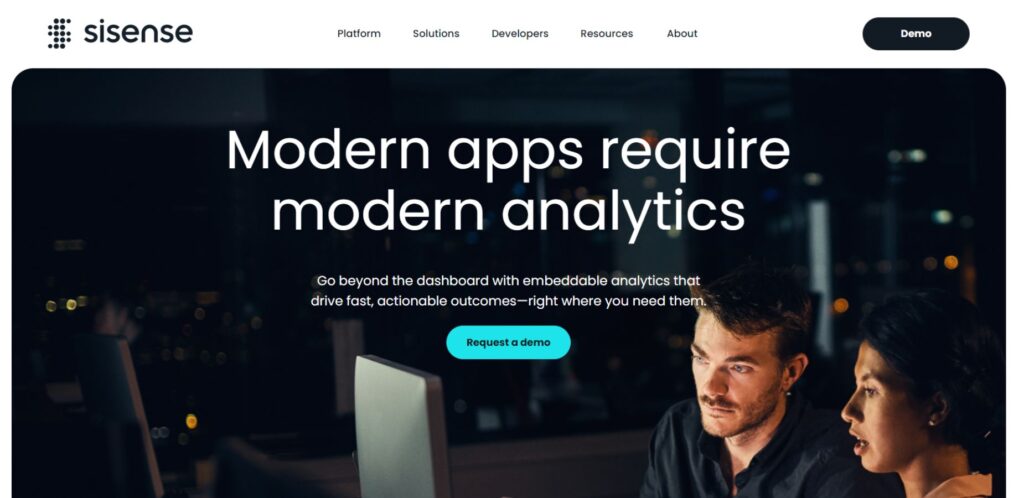
It is a business intelligence and analytics platform that integrates AI capabilities, where AI delivers superior data insights and visualization capabilities. It has its In-Chip technology, which allows easy processing of massive data sets for real-time analytics. Sisense embeds all auto-insights, natural language querying, and predictive analytics.
It is innovative since it sports intrinsic analytics capability that allows organizations to take analytics directly to the applications and workflows. The application does not strain on complex data models; therefore it is suitable for diverse organizations with different sources and structures of data.
Key features:
- In-Chip technology for fast data processing
- AI-driven insights and recommendations
- Natural language search and generation
- Analytics powers embedded
- Customizable dashboard and visualization
- Connectivity to diverse sources and applications
Pros:
- High Performing Capabilities on Large Datasets
- Extremely Flexible and Apt for Self-Service and Embedded
- Allows data models of high complexity, as well as relationships
- Pally for Non-Tech Users
Pricing:
- Custom Price depending on Specific Needs and Options for Deployment
- Free trial available
Website:
https://www.sisense.com
10. Julius AI
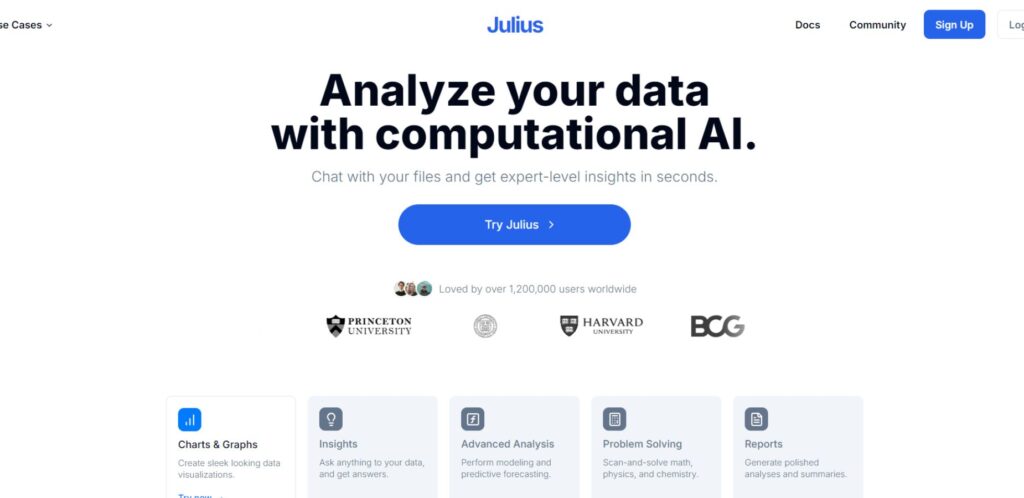
Julius AI is a new entrant in the field of AI-powered data analytics tools but with future-forward solutions towards data analytics and decision-making. Advanced machine learning and natural language processing will be used to make automated insights and predictive analytics. Standing first in the category with its focus on conversational analytics because it will allow interaction with one’s data using natural language queries.
Since the company permitted integration with other data sources also, the platform was friendly in nature that made it accessible to technical and nontechnical users.
Key Features:
- Conversational AI Tool with natural language interactions with data
- Automatic data preparation and cleansing
- Predictive analytics and forecasting
- Integration into numerous data sources
- Collaborative dashboards with reports for business requirement
- Based on the requirement, sharing capabilities
Pros:
- Conversational Analytics with innovative approach
- Friendly Interface: non-technical usage
- It offers flexibility in its integration with other data ecosystems already in place
- It is automatic insights-integrated to make fast decisions
Pricing:
- Basic : $20
- Essential: $ 45
- Pro: $ 60
Website:
https://julius.ai
Benefits of AI-Powered Data Analytics Tools
The use of Ai-based data analytics software and techniques has revolutionized the way businesses operate with gigantic loads of data. The sophisticated tools have several strengths that may impact the performance as well as the decision-making processes of an organization considerably:
1. Higher Accuracy and Speed in Processing
This accuracy and speed added to the availability of AI-based algorithms ensure processing large volumes of data with greater accuracy and rapidity compared to the conventional methods for computation and processing.
2. Deep Pattern Recognition:
AI-driven data analytics tools will recognize intricate patterns and associations of data that even an analyst may overlook. They will bring out insights that may have gone unseen or been missed to transform business growth opportunities.
3. Predictive Analytics
As the AI-based data analytics tools would depend on historical data and learning algorithms, future trends and trends could be predicted with incredibly better accuracy. Predictive analytics will aid in more proactive decision-making and make risks controllable.
4. Automated Insights
Many of these analytics tools can automatically create insights that can be made for those applications. For these, no manual scanning is necessary to throw up key findings and recommendations, thereby saving much time, and data insights made available to non-technical users.
5. Natural Language Processing
These AI-powered data analytics tools use natural language processing, where users interact with the data and create conversational questions as they try to achieve a solution. This helps democratize data analysis across organizations, enabling more employees to extract meaning out of complex datasets.
6. Continual Learning and Improvement
These algorithms learn from new data and interactions with the users. The more it is used, the higher the accuracy level, which would increase the relevant improvements that can be made over time. This adaptability would ensure analytics remains effective as business needs change.
5 Pro tips for choosing the best tool for your business
1. Review your Data Landscape
Reflect on the sources of data you already have access to in what volume and what kind. Then, ensure that the tool you can choose connects well to your existing data infrastructure as well as accounts for the type of demand your data requires.
2. Consider Various Levels of User Expertise
Find one that balances the technical capability of your team. Some are primarily designed to be non-technical-which could make it easier for
nontechnical users-and therefore more intuitive to use. Others would be more suitable for advanced capabilities that a data scientist would require.
3. Evaluate Integration Capability
Clearly, a perfect tool should seamlessly fit with your existing software environment. Find out whether your choice of a tool would easily connect to CRM Software , ERP System, or any other business application where data and information are shared.
4. Scalability and Flexibility
The analytics requirements will surely change with the growth of a business. Choose a tool that scales with the growth of an organization. Verify what particular AI and ML capabilities each tool is offering. Identify those which align to your analytics objectives, be it predictive modeling, natural language processing, or automated ML.
5. Evaluate Total Cost of Ownership
Other costs aside from the acquisition of the system to be considered in a cost-of-ownership consideration include the costs of deployment, training, future maintenance, and customization. You should also weigh your potential return on investment based on business processes and your decision-making tool.
Conclusion
These AI-powered data analytics tools increasingly have emerged as a source of gold for a firm to seize competitive advantage on the present battlefield, which is information-based. More sophisticated tools of this type offer an enlarged and relevant array of benefits, such as higher accuracy and performance, predictiveness, and insights automatically generated.
By leveraging its capacities in AI and machine learning, an organization can discover more profound insights, make more informed decisions, and induce innovation throughout all its functions.
FAQs
Is it better for smaller businesses to use AI-powered data analytics tools?
Yes, because many AI-powered tools are scalable, so they are suitable for businesses of any size.
Do I need a data science team in order to be able to use AI-powered analytics tools?
No. Rather, most of these tools are accessible and usable by people who are not necessarily knowledgeable about data science.
Do I still need human analysts with AI-powered data analytics tools?
These tools complement but do not replace human analysts, augmenting their capacity and freeing them up for higher-level activities.
What is the deployment time for such an analytics tool powered by AI?
Time to deploy will vary depending on the tool you are deploying and what your organization needs are.






